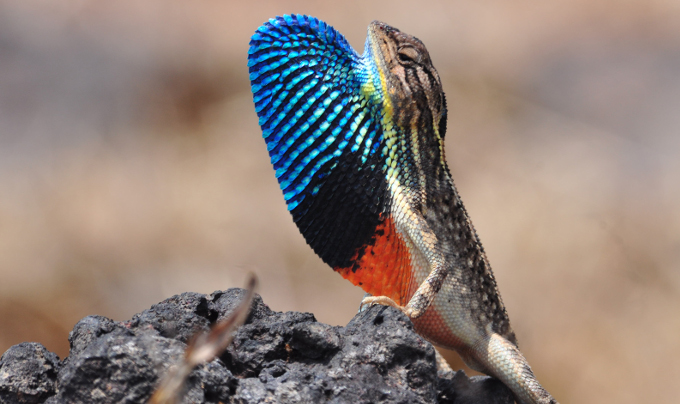Fan-throated lizards of India are a highly diverse group with at least 15 species, possibly caused by climatic shifts around 8–5 million years ago.
Wed, 2017-12-27 16:30
Image credit: Deepak Veerappan
Deepak. V (a postdoc) and Praveen Karanth show that fan-throated lizards consist of at least 15 species, with much of the diversification dating back to 8–5 million years and possibly caused by climatic shifts in India in that period. This is one of the few studies that establishes a link between climate change and adaptation in the Indian subcontinent. The study also highlights the importance of the dry zone as centers of biodiversity.
Fan-throated lizards are small ground dwelling lizards with distinct fan-like structure on their throat that is used to attract mates. They are found in the dry open habitats from across India. Until recently they were thought to be a singe species but recent studies indicate that they consists of multiple species. But the exact nature of diversity of the species and its distribution in India have remained elusive.
To better understand the diversity and distribution of these lizards Dr. Deepak V., who was a post doc in Dr. Praveen Karanth’s lab at CES, IISc, undertook an extensive field and lab based study. Deepak sampled these lizards from over 100 locations across India from Dehradun to Kanyakumari and Rajasthan to West Bengal. His findings based on molecular, morphological and field data indicated that this taxa consists of at least 15 species.
Deepak also determined the evolutionary relationships between these species using DNA sequence data and used an “molecular clock” to determine when these species underwent diversification. Results from his reseach indicate that much of the diversification occurred in the last 8–5 million years ago.
Interestingly it was during this period there was a major climatic shift occurred in India from high rainfall regime to a more seasonal rainfall setting. These climatic changes resulted in the expansion of open grassland habitats that the fan throated lizards adaped to and diversified.
This is one of the few studies that establishes a link between climate change and adaptation in the Indian subcontinent. The study also highlights the importance of the dry zone as centers of biodiversity.
Article: Deepak, V. & Karanth, P. 2018. Aridification driven diversification of fan-throated lizards from the Indian subcontinent. Molecular Phylogenetics and Evolution 120, 53-62.
Link: https://www.sciencedirect.com/science/article/pii/S1055790317304256

Add new comment